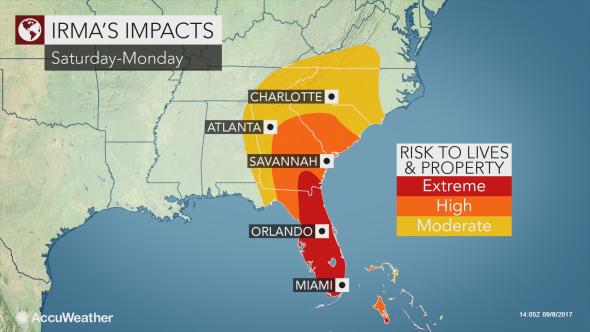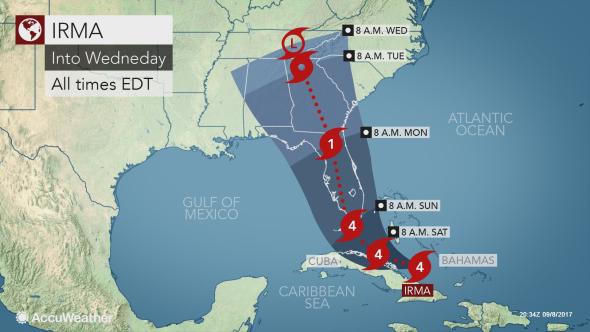Powerful Hurricane Irma is aiming toward the United States after unleashing its full power on the northern Carribean. It is projected that the devastating winds and flooding rain will come to Florida on Saturday.
According to Dr. Joel N. Myers, founder, president, and chairman of AccuWeather this “catastrophic weather event” will definitely hit the United States.
“There will be massive damage in Florida. [It will be] the worst single hurricane to hit Florida since Hurricane Andrew in 1992,” Myers added.
According to the current forecast, Irma will most affect the eastern side of the state which means that Miami, West Palm Beach, Melbourne, Daytona Beach and Jacksonville will be battered the most. The sheer size of this system further implies that powerful winds will reach areas around Tampa, Fort Myers and Sarasota.
In case that the storm moves a little bit more to the west, it would cause Irma to deliver its hardest blows to western Florida and the lower Keys.
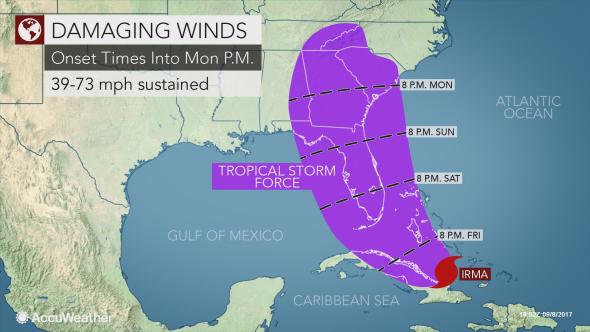
“Irma remains a very powerful and destructive hurricane,” AccuWeather Hurricane Expert Dan Kottlowski stated.
He continued by adding “Impacts within the projected path of Irma include life-threatening wind, storm surge and flooding rainfall hazards.”
Throughout Saturday and Sunday, it is expected for the weather to get significantly worse and to turn into the life-threatening weekend. As Irma approaches winds will accelerate while more rain is coming this way.
Later on, high amount of rain and strong winds will shift across entire Florida Peninsula. All these will come from Sunday into Monday.
Bad news are just piling up, and there are few factors that are making this storm even worse. When we take into account that a few days ago we had a full moon, and that wind is also bringing more water to the shores, it is expected for us to see significant flooding. This will be particularly dangerous during high tide.
According to Myers, Irma is bringing “extremely angry ocean.” He also added, “It’s a monster hurricane out there — it’s bringing along with it something to be feared.”
How powerful this storm really is? Well, it now holds a record for sustained winds of 185mph for 37 hours. Compared to Super Typhoon Haiyan which held it for 24 hours in 2013. Unfortunately, Irma will set a lot of records.
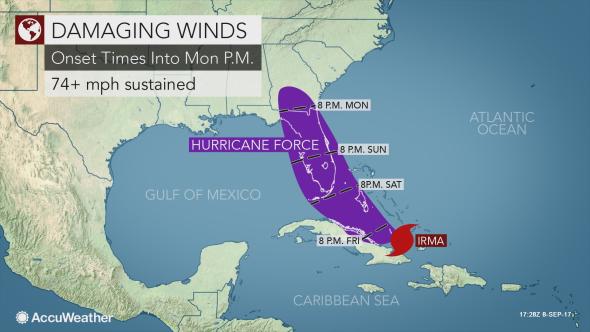
Anything from 4 to 8 inches of rain is expected, and in some areas, it could reach up to a foot. This will definitely pose a big problem especially to those where drainage might not be at the highest level. As a result, we expect to see roads turning into rivers.
Reports are showing that Hurricane Irma is slowing down, but it will still hit some areas with winds of above 150 mph. This is more than enough for it to cause major hazards. Winds that reach this speed could take down trees and power lines while damaging roofs and various infrastructure objects.
Kottlowski added, “Any land within 185 miles of the Irma’s center could see damage and any place within 50 to 60 miles of the center could experience catastrophic damage.”
Consequences of Hurricane Irma will be noticeable all over the world not just in the US when it comes to travel.
One of the most important moments here will be the turn that will this storm make after it finishes with Cuba. Depending on this it will be determined if it will hit southern Florida or it might just go on by the east coast.
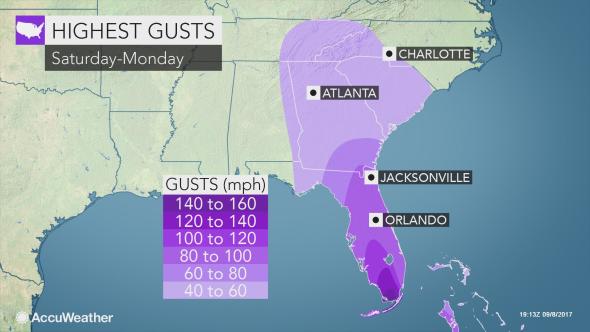
“The timing of this turn is critical for where Irma will track during Sunday,” Kottlowski said.
There is a hope that it might turn quickly and that would result in movement of the center of the storm closer to the Bahamas. If this happens, most affected areas would be east coast of Florida but with the major wind and rain staying over the ocean.
On the other hand, if it turns slower than expected most landfall would occur over the Florida Keys. This would then continue all over the Florida Peninsula and could additionally cause tornados all across the state. Pretty much entire state would be heavily affected by this.
Unfortunately, latest forecast shows that it is possible for Hurricane Irma to make a slower turn.
Have in mind that even if the center of the storm does not hit the land at full force and stays offshore, it will still cause huge problems as it is quite powerful and massive.
Mike Doll, the Senior Meteorologist at AccuWeather, said “Although Hurricane Matthew last year passed east of Jacksonville, they experienced flooding due to water pushing into the St. Johns River. The same thing could happen with Irma.”
Everyone that is anywhere near the storm should pay attention to the situation. Especially those in areas that might get hit hardest need to be prepared for emergency evacuation.
Since Hurricane Irma will continue its destructive journey over Florida and later on it might batter Georgia and Carolina, you need to be prepared. It should slow down in the next few days, but still, this could cause serious problems even to those people that are hundreds of miles away from it.
“AccuWeather’s preliminary estimate of potential economic cost from Hurricane Irma in the U.S. is $50-100 billion.” Myers also added, “If the eye passes right over Miami, then it will be even more.”
